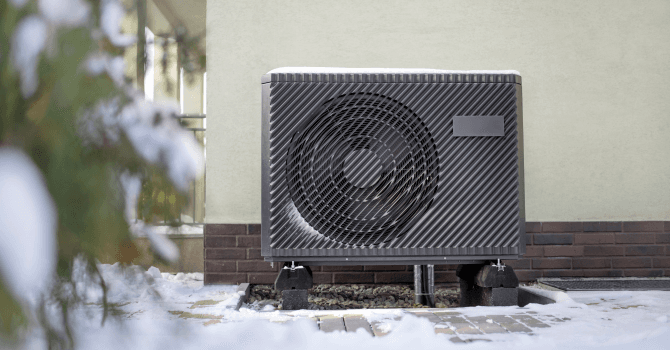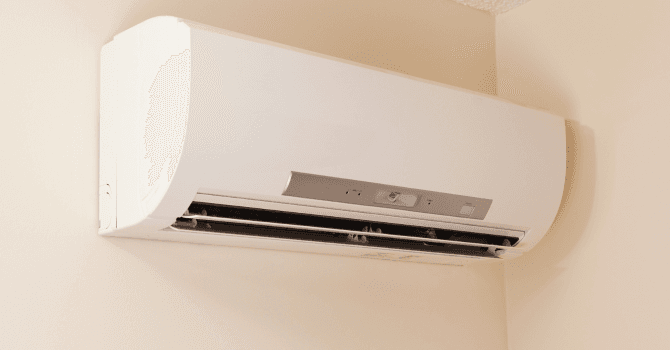How to Calculate the Right Size (BTU) Heat Pump Needed
By Editorial Team
Updated on April 12, 2024
When residing in Quebec—or anywhere else in Canada for that matter—where temperatures vary greatly, the notion of comfort is, first and foremost, linked to your home’s heating and air conditioning systems.
The heat pump is, without a doubt, the most sought-after option for Quebecers. Whether used to cool down your home during summertime or warm it up during the winter, it increases comfort while improving energy efficiency. Provided you figured out the right size heat pump needed.
How to Calculate the BTU Size Needed for a Central Heat Pump

Source: Canva
What are BTUs exactly?
A BTU (British Thermal Unit) is a universal unit of measure of heat, defining the quantity of heat needed to increase the temperature of one pound of water by one degree Fahrenheit at a constant pressure. More simply said, it’s the amount of heat produced or absorbed by a device when it’s used to heat or cool any given space.
It’s important to understand that BTU needs vary seasonally. As such, the power output needed won’t be the same depending on whether you’re heating or cooling a space. With that fact in mind, note that calculating the square footage of the space in question won’t suffice to understand the power output required for a heat pump.
Calculating the Output Capacity per Square Foot

Source: Canva
To determine the quantity of BTUs required for a wall-mounted heat pump, one typically uses the “rule of thumb.” As such, one measures the surface area to cool or heat in square feet by multiplying width times length.
One should look for 1,000 BTUs for 100 square feet. However, in terms of rather spacious settings (1,000 to 1,200 square feet), one will opt for a 12,000 BTU device. On the slip side, for tighter quarters, one will prefer a heat pump with 9,000 BTUs. Lastly, in an open-concept layout with several windows or a cathedral ceiling, it’s best to opt for a 15,000 BTU-sized device.
If the information mentioned above isn’t enough, before resting your decision on a specific unit, consider the following factors:
Number of stories or landings
Where the device is installed
Amount of sunshine the room in question gets
Number of windows and their dimensions
Height of ceilings
Home insulation
Air leaks, etc.
Might as well point out that it’s not a matter of simple math.
You can use the same “rule of thumb” as mentioned for a central heat pump, but you’ll have to multiply the result by two to get an idea of the power output needed. Since the air must be channelled through ventilation ducts, the overall power output needs to be greater.
A central heat pump’s rating can also be measured in cooling tons: one ton equals 12,000 BTU. It’s roughly one ton per 750 square feet. As such, for a 1,500-square-foot home (garage and basement excluded), one will normally opt for a 2-ton heat pump. For a similar-sized home with a significant number of windows or poorly suited insulation, it’s best to opt for a 2.5-ton unit.
In any case, request a quote from an HVAC specialist to ensure you purchase a heat pump that meets your heating and cooling needs.
How to Determine the Output Needed for a Heat Pump

Source: Canva
Simplified Calculation Method
If you want to use this method, here’s what you need to know: for every square foot of living space, you need about 30 BTUs to heat and 15 BTUs to cool.
How many BTUs do you need to heat a home?
To figure it out, multiply the width of the space times its length. Then, multiply the result by 30, and you’ll get the necessary amount of BTUs to heat the area in question.
How many BTUs do you need to cool a house?
To figure it out, multiply the width of the space times its length. Then, multiply that number by 15, and you’ll get the necessary amount of BTUs to air condition the room in question.
How to Determine the Size of Heat Pump Needed
Based on the results obtained, now you have to find an even keel. If you were to rely solely on the results obtained for heating purposes, you’d essentially be purchasing a device that’s deemed too powerful for your summertime needs. On the flip side, if you were to rely solely on the recommended BTUs for air conditioning needs, you’d be opting for a heat pump with an insufficient rating to properly heat the surface area during the winter.
Here’s an example of a calculation based on a 24-foot by 30-foot space.
24 feet x 30 feet = 720 square feet
720 square feet x 30 BTU = 21,600 BTU (heating)
720 square feet x 15 BTU = 10,800 BTU (cooling)
Based on these calculations, you would need a device with a 21,600 BTU rating, on average, to heat the given space, and a 10,800 BTU rating for air conditioning needs. A heat pump with a rating ranging between 15,000 and 18,000 BTU would suit the balance needed between heating and cooling requirements.
CONSIDER THIS: According to Natural Resources Canada, the result obtained should fulfill 125% of the air conditioning needs. As such, if, based on the calculations, you need a 20,000 BTU/h rating for your home to be at a comfortable temperature in the summer, you should install a heat pump with a 25,000 BTU/h rating. A device of said size should meet 80-90% of the annual heating demand. By proceeding as such, you’d be achieving the best cost-effectiveness ratio.
Why is it important to calculate the power output based on needs?

Source: Canva
Before even weighing the practical side of the device’s different functions or energy efficiency, you have to determine the output capacity you need. An unfitting choice may have significant ramifications. A heat pump with an inefficient power output won’t have the capacity to generate the desired heat during those colder, winter days, nor the coolness that’s often sought-after in temperatures nearing 30 degrees. Your device will be running constantly at full power without even meeting your needs. This will not only wear the device prematurely, but it will also result in your electricity bills skyrocketing.
On the other hand, a too-powerful heat pump will constantly waver from an “on” to an “off” mode, since even if it’s programmed at its lowest setting, it will still reach the requested temperature too fast. The device will struggle to dehumidify since it will turn on and off repeatedly. The temperature felt inside the home will be uneven and uncomfortable. Lastly, said mode of operation will wear prematurely the device’s various parts and result in a build-up of ice around the exterior unit.
In a nutshell, one way or another, if the power output is ill-suited to the space’s heating or cooling needs, the device will incur significant damage, resulting in repair fees that could have been avoided, as well as limited service life.
Don’t Forget to Inquire About Available Funding and Subsidies
Subsidies are made available via programs like Rénoclimat through Energy Transition Quebec and Hydro-Québec’s Efficient Heat Pump Program. First-time homebuyers of Novoclimat-certified newly built homes can also benefit from a subsidy by installing a pre-approved heat pump model.
Get 3 quotes for your heat pump installation
RenoQuotes.com can help you get quotes for your air forced-air heating system project. When you submit your project, we’ll then put you in contact with top-rated contractors. Fill in the form on the homepage (it only takes a few minutes) and get estimates from trusted professionals.
Dial 1-844 828-1588 to speak with one of our customer service representatives.
Looking for something else?
Related articles
The latest industry news, interviews, technologies, and resources.

Editorial Team
•19 Sep 2025
In a competitive market like construction and renovation in Quebec City, HVAC contractors need to stand out to land profitable projects. Whether you specialize in heating, ventilation, or air conditioning, this article presents concrete strategies to attract new clients and grow your business in 2025, while providing reliable and locally recognized service.

Editorial Team
•07 Apr 2025
Are you looking for an efficient and discreet solution for your home's thermal comfort? The ducted heat pump is a high-performance option that ensures optimal comfort throughout the year. Unlike wall-mounted models, it is integrated into ventilation ducts, making it virtually invisible. How does it work, and what are its advantages? Here’s everything you need to know about this system to make an informed choice!

Editorial Team
•07 Nov 2023
We can’t deny that painting usually turns out to be a time-consuming activity. Most homeowners love the idea of a fresh coat of paint, but the process of getting there can be tricky. This labour-intensive job needs attention to detail and perseverance, especially if you’re dealing with the age-old debate of how many coats of paint are necessary.

Editorial Team
•26 Aug 2025
In the construction industry, sharing knowledge and mentoring new talent are essential to ensure a wave of succession and to promote the industry. Given this perspective, virtual mentorships prove to be a promising solution. On account of technological breakthroughs and the onset of custom platforms, you can now benefit from remote expert advice.

Editorial Team
•11 Nov 2024
Once considered rustic, perhaps even old-fashioned, ceiling beams have now become a sought-after, stylish design element. Embrace them; unearth their beauty, customize their style to your liking, and genuinely appreciate their presence. Or, draw inspiration from them, create something new, and adapt them to your different indoor settings.